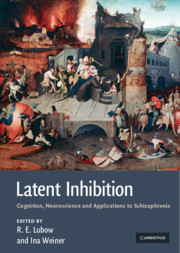Book contents
- Frontmatter
- Contents
- List of contributors
- Preface
- 1 A short history of latent inhibition research
- Current topics in latent inhibition research
- 2 Latent inhibition and extinction: their signature phenomena and the role of prediction error
- 3 Inter-stage context and time as determinants of latent inhibition
- 4 Latent inhibition: acquisition or performance deficit?
- 5 Latent inhibition and learned irrelevance in human contingency learning
- 6 Associative and nonassociative processes in latent inhibition: an elaboration of the Pearce–Hall model
- 7 From latent inhibition to retrospective revaluation: an attentional-associative model
- 8 Latent inhibition and habituation: evaluation of an associative analysis
- 9 Latent inhibition and creativity
- 10 The phylogenetic distribution of latent inhibition
- 11 The genetics of latent inhibition: studies of inbred and mutant mice
- 12 A comparison of mechanisms underlying the CS–US association and the CS–nothing association
- 13 The pharmacology of latent inhibition and its relevance to schizophrenia
- 14 Parahippocampal region–dopaminergic neuron relationships in latent inhibition
- 15 Latent inhibition and other salience modulation effects: same neural substrates?
- 16 What the brain teaches us about latent inhibition (LI): the neural substrates of the expression and prevention of LI
- 17 Latent inhibition in schizophrenia and schizotypy: a review of the empirical literature
- 18 A cautionary note about latent inhibition in schizophrenia: are we ignoring relevant information?
- 19 Latent inhibition as a function of anxiety and stress: implications for schizophrenia
- 20 Nicotinic modulation of attentional deficits in schizophrenia
- 21 Latent inhibition and schizophrenia: the ins and outs of context
- Summary and conclusions
- Index
- References
17 - Latent inhibition in schizophrenia and schizotypy: a review of the empirical literature
from Current topics in latent inhibition research
Published online by Cambridge University Press: 04 August 2010
- Frontmatter
- Contents
- List of contributors
- Preface
- 1 A short history of latent inhibition research
- Current topics in latent inhibition research
- 2 Latent inhibition and extinction: their signature phenomena and the role of prediction error
- 3 Inter-stage context and time as determinants of latent inhibition
- 4 Latent inhibition: acquisition or performance deficit?
- 5 Latent inhibition and learned irrelevance in human contingency learning
- 6 Associative and nonassociative processes in latent inhibition: an elaboration of the Pearce–Hall model
- 7 From latent inhibition to retrospective revaluation: an attentional-associative model
- 8 Latent inhibition and habituation: evaluation of an associative analysis
- 9 Latent inhibition and creativity
- 10 The phylogenetic distribution of latent inhibition
- 11 The genetics of latent inhibition: studies of inbred and mutant mice
- 12 A comparison of mechanisms underlying the CS–US association and the CS–nothing association
- 13 The pharmacology of latent inhibition and its relevance to schizophrenia
- 14 Parahippocampal region–dopaminergic neuron relationships in latent inhibition
- 15 Latent inhibition and other salience modulation effects: same neural substrates?
- 16 What the brain teaches us about latent inhibition (LI): the neural substrates of the expression and prevention of LI
- 17 Latent inhibition in schizophrenia and schizotypy: a review of the empirical literature
- 18 A cautionary note about latent inhibition in schizophrenia: are we ignoring relevant information?
- 19 Latent inhibition as a function of anxiety and stress: implications for schizophrenia
- 20 Nicotinic modulation of attentional deficits in schizophrenia
- 21 Latent inhibition and schizophrenia: the ins and outs of context
- Summary and conclusions
- Index
- References
Summary
Introduction
Schizophrenia is a severe neuropsychiatric disorder of unknown aetiology. The condition is clinically heterogeneous and affects virtually all areas of life, often resulting in disabling cognitive, perceptual, and emotional symptoms. The symptoms of schizophrenia are generally classified as positive (e.g. hallucinations and delusions), negative (e.g. anhedonia, alogia, thought paucity) and cognitive (e.g. thought disorder, bizarre thinking). The disease course is often chronic and the financial cost on the health-care system and society is tremendous, in addition to the personal consequences of the illness for friends and family of sufferers (Mangalore & Knapp,2007; McEvoy, 2007). Tragically, a substantial number of patients commit suicide.
The most successful treatments for schizophrenia that are currently prescribed are pharmacological, and most of these involve blockade of striatal dopamine receptors (Kapur & Remington, 2001). These treatments are successful in reducing the acute symptoms of the condition but provide no cure; accordingly, the need for a better understanding of the aetiology and pathophysiology of schizophrenia and the development of novel treatments is considerable. Drug development draws on many experimental strategies as well as on serendipity (Carpenter & Koenig, 2008; Javitt et al., 2008); translational models such as latent inhibition (LI) play an important role in the strategic effort to develop new treatments (Weiner, 2003). Indeed, a wealth of animal data exist that support the utility of the LI paradigm in studies of antipsychotic treatments (e.g., Weiner, this volume).
- Type
- Chapter
- Information
- Latent InhibitionCognition, Neuroscience and Applications to Schizophrenia, pp. 417 - 447Publisher: Cambridge University PressPrint publication year: 2010
References
- 7
- Cited by



